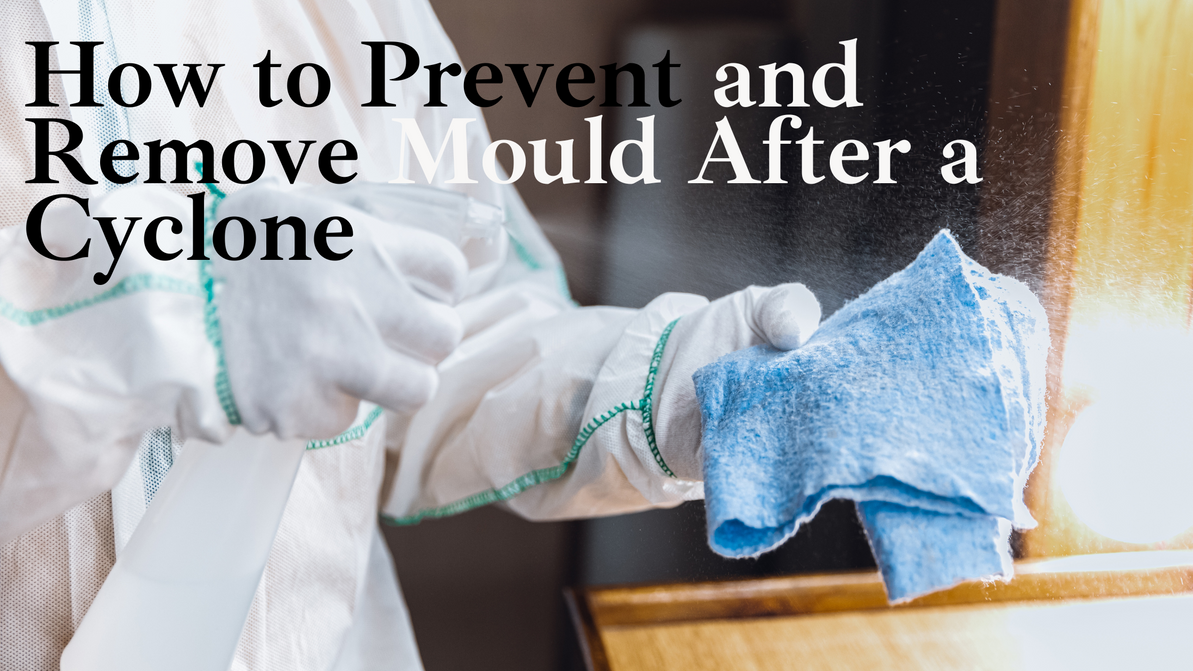How to Prevent and Remove Mould After a Cyclone: Essential Steps for Australian Families
In early March 2025, Tropical Cyclone Alfred struck Queensland and northern New South Wales, bringing heavy rainfall and widespread flooding. The extreme weather left many homes vulnerable to mould growth, creating an urgent need for effective cleanup and prevention strategies.
Cyclones bring heavy rain and flooding, creating the perfect environment for mould to thrive. If left unchecked, mould can cause serious health risks and structural damage to your home. Acting quickly and effectively is key to preventing long-term issues. Here’s everything you need to know about mould prevention and removal after a cyclone.
1. Why Mould is a Serious Issue After a Cyclone
Mould thrives in damp, humid environments—conditions that are common after a cyclone due to flooding and prolonged moisture exposure. If mould is not removed properly, it can:
- Trigger allergic reactions and respiratory issues, particularly for children, the elderly, and those with asthma.
- Weaken structural materials like plaster, wood, and insulation.
- Spread rapidly, making it harder and more costly to remove over time.
After Cyclone Alfred, many Australian families have been dealing with the aftermath of flood-damaged homes, making mould removal a top priority.
2. Act Fast: The First 48 Hours Matter
Mould can begin growing within 24–48 hours after water exposure. To stop it from spreading:
- Remove excess water immediately – Use a pump, wet vacuum, or mop to eliminate standing water.
- Increase airflow – Open windows, doors, and use fans to circulate fresh air.
- Dehumidify – If possible, use a dehumidifier to reduce excess moisture.
- Discard unsalvageable items – Porous materials like carpets, mattresses, and soft furnishings that have been waterlogged should be disposed of.
3. How to Safely Remove Mould
Mould removal requires proper safety precautions to prevent exposure to spores.
- Wear protective gear – Use gloves, an N95 mask, and goggles to avoid inhaling mould spores.
-
Use the right cleaning solution:
- Vinegar and water (1:4 ratio) – A natural and effective way to kill mould.
- Commercial mould removers – Ensure they are non-toxic and safe for household use.
- Avoid bleach for porous surfaces – Bleach may kill surface mould but won’t eliminate spores embedded in walls or wood.
- Scrub thoroughly – Use a stiff brush or sponge to remove visible mould from hard surfaces.
- Dry the area completely – Any remaining moisture can encourage mould to regrow.
4. Preventing Mould from Coming Back
After cleaning, take these steps to prevent mould from returning:
- Continue ventilating your home – Keep air circulating with open windows and fans.
- Check for leaks – Inspect your roof, windows, and pipes for ongoing moisture issues.
- Use mould-resistant paint – If repainting, choose mould-resistant products for walls and ceilings.
- Keep humidity levels low – Regular use of dehumidifiers and air conditioning can help maintain dryness.
- Monitor for regrowth – Regularly check common problem areas like bathrooms, kitchens, and ceilings.
5. When to Call a Professional
If mould covers a large area (more than 1 square metre), is growing in HVAC systems, or has deeply penetrated walls, professional remediation may be necessary. Specialists have the tools and expertise to remove mould safely and prevent further contamination.
Final Thoughts
The aftermath of Cyclone Alfred has left many homes at risk of mould infestation, but taking the right steps early can prevent major damage. Protect your home and health by acting quickly, using the right cleaning techniques, and maintaining good ventilation. If in doubt, seek professional help to ensure your home is completely mould-free.
Stay safe, act fast, and help keep your home healthy for your family.
Recent Posts
-
The Sink Warehouse Unveils the New Roma Floor-Standing Vanity Range
Perth, Australia – October 2025 — Following the success of last year’s Roma Fluted Wall-Hung Vanitie …30th Oct 2025 -
The Sink Warehouse Mega Reno Sale: Big Renovation Savings Before Christmas
The Sink Warehouse Mega Reno Sale: Big Renovation Savings Before Christmas Perth, Australia – Octobe …30th Oct 2025 -
Upgrade Your Space with the Perfect Fit Series – New from The Sink Warehous
Your kitchen is more than just a space—it’s the heart of your home. Whether you're renovating o …14th Apr 2025




